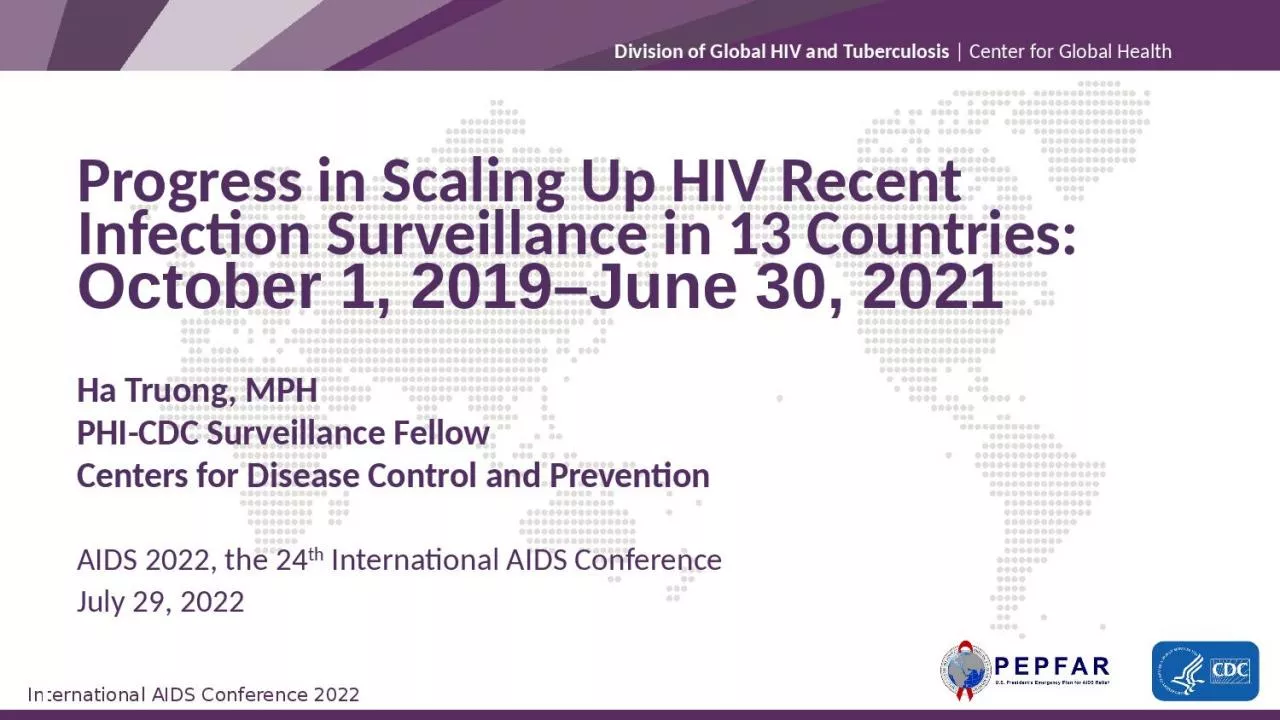

October 1 2019 June 30 2021 Ha Truong MPH PHICDC Surveillance Fellow Centers for Disease Control and Prevention AIDS 2022 the 24 th International AIDS Conference July 29 2022 Recent infection surveillance ID: 1042235
Download Presentation The PPT/PDF document "Progress in Scaling Up HIV Recent Infect..." is the property of its rightful owner. Permission is granted to download and print the materials on this web site for personal, non-commercial use only, and to display it on your personal computer provided you do not modify the materials and that you retain all copyright notices contained in the materials. By downloading content from our website, you accept the terms of this agreement.
1. Progress in Scaling Up HIV Recent Infection Surveillance in 13 Countries: October 1, 2019–June 30, 2021Ha Truong, MPHPHI-CDC Surveillance FellowCenters for Disease Control and PreventionAIDS 2022, the 24th International AIDS ConferenceJuly 29, 2022
2. Recent infection surveillanceIntroduction: Recent infection surveillanceData to actionProgram strengtheningDescribe trends among persons classified as recentData analysisData collectedRTRI: rapid test for recent infectionRITA: recent infection testing algorithm
3. To describe global progress in implementing recent infection surveillance in PEPFAR-supported countriesObjective:PEPFAR: U.S. President’s Emergency Plan for AIDS Relief
4. Methods: Data and inclusion criteriaData: Source: Site-level, quarterly aggregate PEPFAR monitoring and evaluation data for HIV positive test results, and RTRI and RITA results Reporting period: October 1, 2019–June 30, 2021 (7 quarters)Site: health facility or community site offering HIV testing servicesAge: persons ≥15 years Inclusion criteria: RTRI analysis: Countries reported at least 4/7 quarters of RTRI data RITA analysis: Countries reported at least 4/7 quarters of RITA dataRTRI: rapid test for recent infection, RITA: recent infection testing algorithm
5. Outcomes:RTRI: rapid test for recent infectionRITA: recent infection testing algorithm Caveats: PEPFAR site-level data are reported in aggregate. Persons may test at and be reported by multiple sites. This may result in a lower estimate of coverage.
6. Results: Recency analysis flowchartRTRI: rapid test for recent infection RITA: recent infection testing algorithm N=22 countries with RTRI dataN=13 countries with ≥ 4/7 quarters of RTRI dataN=11 countries with RITA dataN=7 countries with ≥ 4/7 of RITA datan=9 countries with < 4/7 quarters of RTRI data excludedn=2 countries with no RITA data excludedn= 4 countries with < 4/7 quarters of RITA data excludedEswatini, Ethiopia, Guatemala, Malawi, Namibia, Nicaragua, Nigeria, Rwanda, Thailand, Uganda, Vietnam, Zambia, ZimbabweEswatini, Nigeria, Rwanda, Thailand, Uganda, Vietnam, Zambia
7. Heat map of RTRI site coverage by country:13 PEPFAR-supported countries; October 1, 2019–June 30, 2021 RTRI: rapid test for recent infection, RITA: recent infection testing algorithm
8. Heat map of RTRI testing coverage by country: 13 PEPFAR-supported countries; October 1, 2019–June 30, 2021 RTRI: rapid test for recent infection, RITA: recent infection testing algorithm
9. Heat map of RITA site coverage by country:7 PEPFAR-supported countries; October 1, 2019–June 30, 2021 RTRI: rapid test for recent infection, RITA: recent infection testing algorithm *Quarterly coverage % removed because % was above 100%
10. Heat map of RITA testing coverage by country: 7 PEPFAR-supported countries; October 1, 2019–June 30, 2021 RTRI: rapid test for recent infection, RITA: recent infection testing algorithm *Quarterly coverage % removed because % was above 100%
11. DiscussionRTRI site and testing coverage increased overall RTRI coverage decreased briefly April 1–June 30, 2020, possibly due to:PEPFAR guidance to temporarily pause recent infection testing in March 2020Disruptions in HIV testingCOVID-19 mitigation effortsRITA coverage decreased for 4 countries, possibly due to:Larger increase in number of sites providing RTRI testing compared to RITA testingChallenges in implementing and reporting viral load testing for RITACOVID-19 mitigation activities
12. LimitationsSome RTRI and RITA data were excluded due to reporting errors resulting in quarterly coverage (%) ≥ 100%The RTRI and RITA testing coverage presented are estimates because site-level data are aggregate and non-deduplicated
13. ConclusionsCountries implementing recent infection surveillance increased RTRI coverage during the reporting periodContinued support for viral load testing, an important component of recent infection surveillance, can help countries improve RITA coverage
14. AcknowledgementsNational Ministries of HealthIn-country PEPFAR teams, local staff, and implementing partnersTracking with Recency Assays to Control the Epidemic (TRACE) implementing partnersPEPFAR InteragencyDepartment of DefenseDepartment of StateUS Agency for International DevelopmentCDC country offices and headquarters
15. Acknowledgements continuedHa T. Truong1,2, Melissa M. Arons1, Mary E. Schmitz3,4, Munyaradzi Pasipamire5, Ashenafi Haile6, Yared Tedla6, Getinet Abera6, Nasim Farach7, Cristine Gutierrez7, Nellie Wadonda-Kabondo8, Danielle Payne8, Anita Beukes9, Ismelda Pietersen9, Matthias Alagi10, Gbenga Asalou10, Ida Kankindi11, Samuel S. Malamba11, Chonticha Kittinunvorakoon12, Anthony Mubiru13, Bui Thi Thu Hien14, Quoc C. Nguyen14, Peter Minchella15, Elizabeth Gonese16, Stephanie Behel1, Ernest L. Yufenyuy1, Shazad Ahmed1, Nicole Zender17, Helen Dale1, Parviez Hosseini17, Ornella L. Nzoutchoum3,4, Elizabeth R. Sharp3,4, Bharat Parekh1, Michael Martin1, Monita R. Patel11Division of Global HIV and Tuberculosis, Centers for Disease Control and Prevention, Atlanta, Georgia, USA2Public Health Institute/Centers for Disease Control, Global Health Fellowship Program, Atlanta, Georgia, USA3U.S. Military HIV Research Program, Walter Reed Army Institute of Research, Silver Spring, Maryland, USA4Henry M. Jackson Foundation for the Advancement of Military Medicine, Bethesda, Maryland, USA5Centers for Disease Control and Prevention, Kingdom of Eswatini6Centers for Disease Control and Prevention, Ethiopia7Centers for Disease Control and Prevention, Central America Region8Centers for Disease Control and Prevention, Malawi9Centers for Disease Control and Prevention, Namibia10Centers for Disease Control and Prevention, Nigeria11Centers for Disease Control and Prevention, Rwanda12Centers for Disease Control and Prevention, Thailand13Centers for Disease Control and Prevention, Uganda14Centers for Disease Control and Prevention, Vietnam15Centers for Disease Control and Prevention, Zambia16Centers for Disease Control and Prevention, Zimbabwe17Office of the U.S. Global AIDS Coordinator and Health Diplomacy (OGAC), U.S. Department of State, Washington, D.C., USA
16. SCAN HERE FOR MORE INFORMATIONABOUT DGHTThe views expressed are those of the authors and should not be construed to represent the positions of the U.S. Army, the U.S. Department of Defense, or the Henry M. Jackson Foundation for the Advancement of Military Medicine